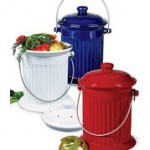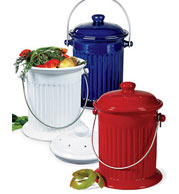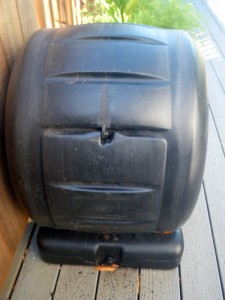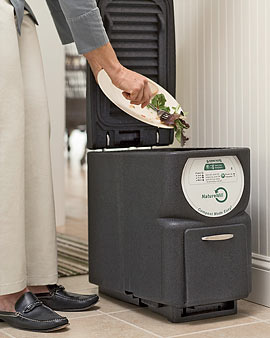
It’s always a challenge to get those kitchen scraps and old food from the refrigerator into the compost pile. You need something right on counter to throw those trimmings into until it’s time to take the long walk outside. Actually, it shouldn’t be a long walk. If it’s snowing or raining, you want that compost bin easy to get to. However, you don’t want it so close to the house that there are smells or flies. (Of course, ideally, there shouldn’t be any smells or flies, but, alas, life is not always “ideally”).
Positioning your compost bin is almost a fine art. It needs to be near the kitchen, out of site of window views, away from outdoor sitting areas, and accessible to get the finished compost.
Positioning also depends on the size of your bin. How big is your family and how much waste do you produce in the kitchen and from the garden?
If you have 1 or 2 people and a small garden, you should consider one of these round bins that take up very little room and work quite well. This bin is large enough to accommodate regular contributions from both the kitchen and a small garden.
The main concern is food scraps that may attract unwanted pests. The best way to deal with this is to use an enclosed bin and have leaves or sawdust to add each time you add wet kitchen garbage.
The most deluxe composter available is this electric one, which you can put in the garage or on a porch. It really does the work and gives you finished compost in two weeks.
2 Responses to “How to Make Composting Easier”
Sorry, the comment form is closed at this time.

 Follow
Follow




[…] Compost is excellent for most plants. It can be bought or you can use your own. I found it difficult to make enough of my own compost to cover all my garden. So I used it on the most important plants – my vegetables and strawberries. Be aware that compost can have weed seed. There are many sources for good looking, safe compost. (Contact your local soil and amendment supply store.) […]
[…] The best way to get excellent roots is to have loose, friable soil with plenty of humus and organic matter. By working the soil with a fork or rototiller and incorporating compost and/or manure you create the conditions for the soil to be like a sponge that holds and then releases water. Read more about compost here. […]